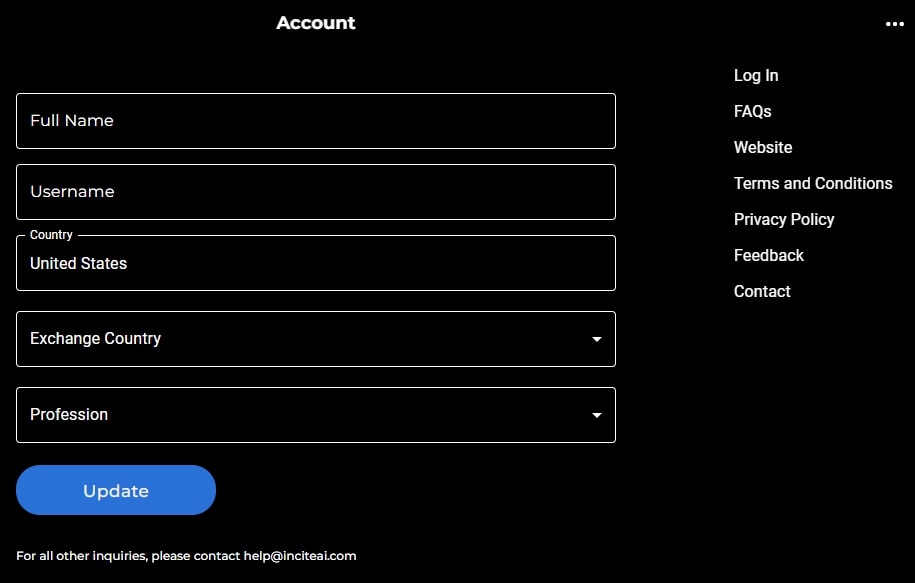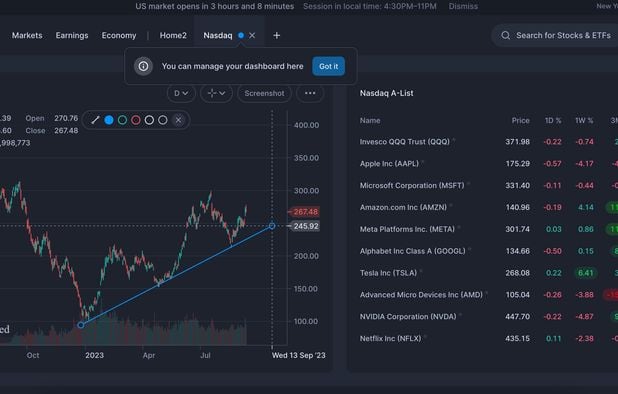Top 10 Tips To Evaluate The Market Coverage Provided By Ai-Powered Stock Predicting/Analyzing Platforms
Market coverage is an essential aspect to consider when looking at AI platform for predicting or analyzing stocks in that it defines the breadth and depth of markets and assets you are able to access. Market coverage is crucial as it lets you diversify, discover global markets, and adapt to different strategies for trading. Here are the top ten tips to determine the market coverage of these platforms.
1. Evaluate Supported Asset Classes
Stocks: Make sure that the platform contains stocks from all the major stock exchanges, which include NYSE, NASDAQ and LSE.
ETFs Find out if the platform allows you to choose from a large number of ETFs that gives you an array of exposure.
Futures and options: Determine whether the platform supports derivatives like options, futures, and other instruments that leverage.
Commodities and Forex. Check to see if there are forex pairs that are available, in addition to precious metals, energy commodities, and agricultural commodities.
Cryptocurrencies Check whether the platform can support popular cryptocurrencies like Bitcoin, Ethereum, and altcoins.
2. Check Geographic Coverage
Global markets: Ensure that the platform includes major global markets such as North America, Europe and Asia-Pacific.
Regional focus: Find out whether the platform is focusing on particular market segments or regions which match your trading preferences.
Local exchanges. Determine whether the platform supports regional or local exchanges pertinent to your location or your business’s strategy.
3. Assessment Real-time as opposed to. Delayed Data
Real-time Market Data: The platform must offer real-time trading information that allows for quick decision-making.
Delayed data: Find out if you can get delayed data for free, or at a lower cost. This may be enough for long-term investors.
Data latency: See if the platform minimizes data latency, specifically for high-frequency trading.
4. Review the availability of historical data
The breadth and depth of historical data: Make sure that your platform is equipped with extensive historical data (e.g. for at minimum 10 years) to allow backtesting.
Look for granularity. Historical data could include daily, intraday and weekly level of granularity.
Corporate actions – Verify historical data to ensure that it covers stock splits, dividends, as well as other corporate actions.
5. Check the market depth and order book data
Platform should provide Level 2 data (order-book depth) to enhance price search and execution.
Verify that your platform displays real-time price spreads.
Volume data – Verify whether the platform provides detailed volume information for analyzing market activities and liquidity.
6. Assess the Coverage of Indices Sectors
Major indices: Check that the platform covers major indices (e.g., S&P 500, NASDAQ 100, FTSE 100) for benchmarking and index-based strategies.
Sector-specific data : Determine if your platform has data specific to certain sectors (e.g. healthcare, technology energy, healthcare) to allow targeted analyses.
Custom-made indices. Find out if you are able to create or track custom indices using your requirements.
7. Evaluate integration with News and Sentiment
News feeds – Ensure the platform has integrated real-time news feeds that contain news that are market-moving from reliable (e.g. Bloomberg or Reuters) sources.
Sentiment Analysis: Check if the platform offers tools for analyzing sentiment that are based on news, social media, or other sources of data.
Event-driven strategies: Determine whether the platform supports the use of event-driven trading strategies (e.g., earnings announcements or economic reports, etc.).
8. Check for Multimarket Trading Capabilities
Cross-market Trading: Verify that the platform allows traders to trade across a variety of market segments and asset classes using an unifying interface.
Conversion to currencies: Make sure the platform supports multi-currency as well as automated conversion of currencies for international trade.
Support for time zones: Check that your platform supports the ability to trade in multiple time zones.
9. Examine the coverage of alternative sources
Alternative data: See whether the platform incorporates alternative data sources (e.g., satellite imagery internet traffic, credit card transactions) to gain unique insights.
ESG data. Find out if the platform has socio-economic, environmental and governance information for socially responsible investing.
Macroeconomics data: To conduct a an analysis of fundamentals, make sure the platform is stocked with macroeconomic indicators like GDP (gross domestic product) inflation rates, GDP and interest rate.
Review Market Reputation and User Recommendations
User reviews: Study user feedback to gauge the coverage of the platform’s market and the reliability.
The reputation of the company: Find out if the platform has been acknowledged by experts in the industry for its market coverage.
Case studies: Look for case studies or testimonials that highlight the platform’s success in certain markets or asset classes.
Bonus Tips
Free trial period: Check the coverage in the marketplace of the platform and the quality of its data with a demo or free trial.
API access: Verify if the platform’s API permits access to market data programmatically to create custom analysis.
Support for customers. Be sure the platform can provide support in relation to data or market queries.
Following these tips can aid you in assessing the market cover of AI stock-Predicting/Analyzing trading platforms. You’ll be able to choose one that gives you access to markets and data for profitable trading. Comprehensive market coverage lets you to diversify and explore the possibilities of your portfolio. It also allows you to adjust to changes in the market. See the top rated AI stocks for blog recommendations including ai trading, ai for stock predictions, using ai to trade stocks, AI stock, best ai trading software, ai for stock trading, ai investing platform, AI stock, best AI stock, ai trade and more.

Top 10 Tips On Assessing The Regulatory Compliance Of Ai Stock Prediction/Analyzing Trading Platforms
The regulatory compliance of trading platforms that use AI to analyze or predict the price of stocks is a significant element. Compliance is essential as it guarantees that the platform adheres to the laws and regulations. Also, it protects users’ data. Here are 10 top tips to assess the regulatory compliance on these platforms.
1. Verify Licensing and Registration
Regulatory Authorities: Make sure that the platform registered with the appropriate regulatory authorities (e.g. SEC US, FCA UK and ASIC Australia) and has an appropriate license.
Broker partnerships: If the platform is integrated with brokers, ensure that the brokers are also properly licensed and regulated.
Public records: Visit the regulatory body’s website for the status of registration as well as any previous violations.
2. Measure Data Privacy Compliance
GDPR when operating in the EU or providing services to users there the platform must be in compliance with the General Data Protection Regulation.
CCPA: California Consumer Privacy Act compliance is required for all users.
Policies on handling data. Review the platform’s privacy policy and make sure it clearly describes the ways in which data regarding users is collected, shared and kept.
3. Examine Anti-Money Laundering(AML) Measures
AML policies: Ensure the platform has robust AML policies in place to detect and prevent the laundering of money.
KYC procedures: Find out whether the platform supports Know Your Customer (KYC), which verifies user identities.
Monitor transactions: Check if the platform is capable of monitoring transactions and reporting suspicious activities to the relevant authorities.
4. Verify Compliance with Trading Regulations
Market manipulation: Make sure the platform has measures in place to stop manipulating the market, such as spoofing and wash trading.
Order types. Verify that the platform is in compliance with the regulations pertaining to order types (e.g. there isn’t any illegal stop loss hunting).
The best execution: Ensure that the platform uses best execution techniques to complete trades at the most competitive cost.
5. Cybersecurity Assessment
Data encryption: Make sure the platform uses encryption to protect the data of users in transit and at rest.
Incident response. Verify that there is a clearly defined incident response plan for the platform to deal with cyberattacks and data breaches.
Certifications: Check if the platform has cybersecurity certifications (e.g., ISO 27001, SOC 2).
6. Review Transparency and Disclosure
Fee disclosure: Ensure that the platform clearly discloses the fees, including additional charges or hidden charges.
Risk disclosure: Check if the platform provides explicit information about risk. Especially for high-risk and leveraged trading strategies.
Performance reporting – Check to determine if there are accurate and transparent performance reports provided by the platform for its AI models.
7. Verify that you are in compliance with International Regulations
Trading cross-border If you plan to trade internationally, make sure your platform is legal in all jurisdictions.
Tax reporting: See if the platform offers tools or reports that help users adhere to tax regulations.
Conformity with sanctions: Ensure whether the platform is in compliance with international sanctions, and is not able to trade with countries or entities that are banned.
8. Review Audit Trails and Record-Keeping
Records of transactions: The platform needs to keep detailed records of the transactions that are used for audit and regulatory purposes.
User activity records: Verify whether the platform is recording users’ activities, such as logins or transactions as well as changes in account settings.
Audit readiness: Make sure that the platform is able to supply all the necessary documentation and logs if the need for a regulatory audit arises.
9. Make sure you are in compliance with AI-specific Regulations
Algorithmic rules for trading: If the platform permits the use of algorithms, it should conform to European regulations such as MiFID II and U.S. Reg SCI.
Bias and Fairness: Verify that the platform detects, and mitigates, biases within its AI models to ensure fair trading.
Explainability – Make sure that the AI platform can clearly and concisely explain regarding AI-driven predictions, decision-making and more. in accordance with certain regulations.
10. Review Feedback from Users and Review Regulatory History
User reviews: Study user reviews to determine the reputation of the platform’s regulator compliance.
History of regulatory violations – Check to find out if the platform is known for any past penalties or violations of regulations.
Third-party inspections: Check if the platform is subjected to regular third-party inspections in order to verify compliance.
Bonus Tips
Legal consultation: Consult an expert in the field to determine whether your website is compliant with regulations.
Free trial period: You can avail a demo or a free trial to evaluate the compliance features of the platform as well as its documentation.
Support for customers: Make sure the platform offers support for compliance-related queries or concerns.
With these guidelines, it is possible to assess the degree of compliance with regulations within AI stock trading platforms. This will enable you to choose a platform which is legal and will protect your interests. The compliance not only reduces the legal risk but also builds confidence in the platform’s services. Have a look at the most popular ai options recommendations for site examples including best ai for stock trading, AI stock analysis, how to use ai for copyright trading, stock trading ai, stock trading ai, trading ai tool, best AI stocks to buy now, ai investment tools, ai options trading, best ai penny stocks and more.

